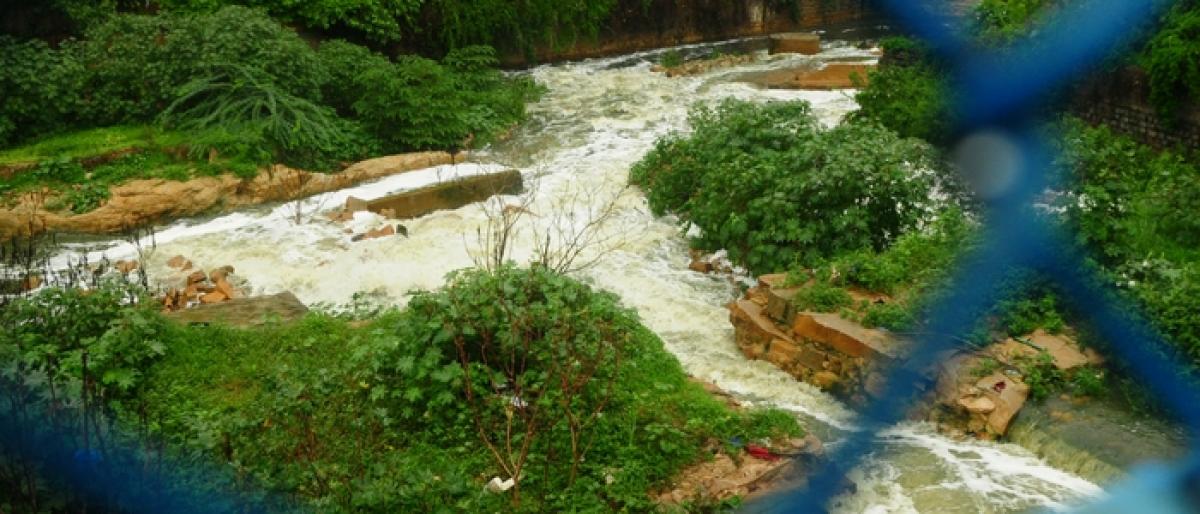Live
- A Guide to Temperature and Humidity Standards in Data Center Server Rooms
- Gadwal collector briefs on details of voters
- Jupally Krishna Rao takes part in Alampur rallu
- Bharath Prasad files 3rd Nomination
- Baisakh Month: A Time of Auspicious Beginnings and Sacred Festivals
- Oust BJD govt for overall development, says Shah
- Unveiling the Hidden Gems: Surprising Health Benefits of Garlic Peels
- Overcoming Sleep Struggles: A Comprehensive Guide to a Restful Night
- RTC bus hit the auto
- MLA Kuchukula Rajesh Reddy participated in the Birappa festival
Just In

While Hyderabad is inundated, neither the Greater Hyderabad Municipal Corporation (GHMC) nor the Water Board officials can say how much storm water or surface run-off in a given area is going a-begging. Officials though are certain that 90 per cent of the rainwater is wasted and does not percolate to recharge groundwater.
With poor harvesting efforts, 90% rainwater runs off
Hyderabad: While Hyderabad is inundated, neither the Greater Hyderabad Municipal Corporation (GHMC) nor the Water Board officials can say how much storm water or surface run-off in a given area is going a-begging. Officials though are certain that 90 per cent of the rainwater is wasted and does not percolate to recharge groundwater.
A rainwater harvesting scheme in which 70 per cent of the cost borne by GHMC was launched a few years ago, did not elicit good response from the people. Even many government buildings do not have water harvesting pits. In some of the offices like Hyderabad and Ranga Reddy collectorates where the pits were dug, there is no maintenance and have become defunct.
Even the untreated water that gets into Hussainsagar with a mix of chemicals and biological pollutants does not help the water body. Dr B V Subba Rao, who has been working on lakes in Telangana, says: “There is an urgent need for a comprehensive study on runoff water in the city and unless the government does not remove the encroachments along the Musi catchment area there is no hope.”
Thousands of cusecs of rainwater getting wasted as the supply channels have been choked.
Dr Shakeel Ahmed, chief scientist, CSIR-National Geophysical Research Institute (NGRI) and team leader Indo-French Centre for Groundwater Research (IFCGR) says, “The amount of rainfall that enters into the sub-surface could be quantified in hard rock region (rural areas) as about 10 per cent, but in Hyderabad, the entire hydrology changes. The infiltration will be much less due to concrete structures.”
Runoff depends on slope and soil types but there has been no study conducted in Hyderabad except for one on Hussainsagar catchment area in 2014. R Devender Prasad, Deputy Director, Hydrology, Groundwater Department says, “The 2014 study showed that 70 per cent of the runoff entering into Hussainsagar was from the Kukatpally nala.
The study revealed that the construction of multi-storied buildings and over-exploitation of groundwater caused deeper water levels in Qutbullapur, Yousufguda, Kukatpally and Hasmathpet watersheds.
On an average, 70 million litres per day (mld) runoff water enters Hussainsagar and another 30-40 mld from other nalas. Dr Subba Rao says, “Hyderabad was blessed with lakes and was designed in such a way that it was a rain resilient city but the connectivity between rains and lakes got cut, water bodies have disappeared. Runoff water if stored could solve half the problem.”

© 2024 Hyderabad Media House Limited/The Hans India. All rights reserved. Powered by hocalwire.com







